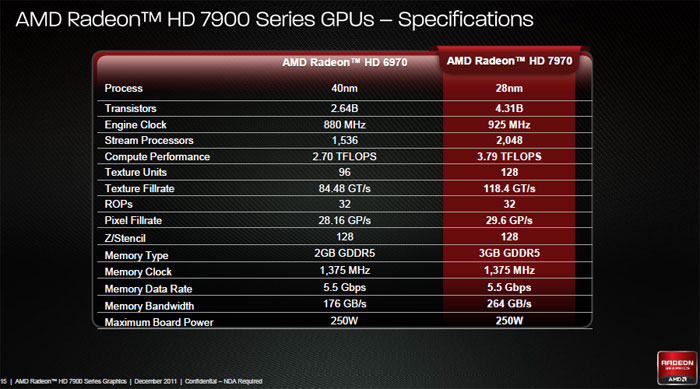Specs and Southern Islands
So it's 22 December 2011, and AMD wanted to go out this year with a bit of a bang, before Christmas starts. At the time of writing this (a week prior to launch) there are some rumors that stores will have some stock today. But if not expect the first and second week of 2012 to be a more decent target. In that timeframe, just before CES 2012 starts in Las Vegas, the Radeon HD 7950 will launch as well. We however are not allowed to talk about that product just yet.
As you have witnessed in the introduction AMD is changing their high-end graphics GPU's strategy and architecture within the first 12 months already, which is a fast pace in terms of technology development anno 2012.
NVIDIA on the other side merely refreshed their architecture a little going from the GTX 480 towards GTX 580. Fermi initially was released back in March/April 2010 which shows that at this very moment AMD is more aggressive in their development path.
It's for good reasons though, AMD's 6900 series are incredibly fun, but have a hard time keeping up with the competition. Hence the architecture of the new GPU (Tahiti) opposed to Cayman (R6900) needed to be changed, and it did, quite significantly.
Southern Islands
You've been hearing about several codenames and that can be a little confusing. It's simple really, in the market we have entry level, mainstream and high-end products. When you notice "Verde" that's entry level. Pitcairn will be the codename the mainstream products will hide under, and finally Tahiti is the codename for the most high-end products.
- Entry level = Verde = Radeon HD 7700 series
- Mainstream level = Pitcairn = Radeon HD 7800 series
- High-end level = Tahiti = Radeon HD 7900 series
The entire segment from top to bottom will be released in Q1 2012, starting off today with the Radeon HD 7970
Technology
We'll focus on the 7900 series today of course, but it is important to understand that there are significant changes in this Family of GPUs. The GPU architecture was overhauled, AMD moved towards a 28nm process technology, the new cards are PCIe gen 3 compatible and there have been significant changes on power consumption. We'll address all the features separately of course.
With the launch of the Radeon HD 7000 series you will also see Eyefinity updated towards version 2.0 DDM audio is now fully supported (you hear audio on the actual monitor it's played of), a new 5x1 landscape mode is introduced, and you may now create custom multi-monitor resolutions.
Let's break things down.
Radeon HD 7970
Right, we start of with the GPU overview (architecture we'll discuss later). AMD now bakes GPU's on the all new 28nm node, in very simple wording that means they can put more transistors on a smaller area. The Tahiti core has a stunning 4.3 Billion transistors, 4,312,711,873 to be precise!
The internal architecture has changed, we'll talk a little deeper about that in a minute. But as a result, the R7970 is packed with 2048 shader processors harbored in Compute Units segments (32 of them).

Memory volume wise the rumors where right, the card will pack a massive 3 Gigabyte of DDR5 memory. This is not done for bragging rights, but AMD simply takes Eyefinity and multiple monitor usage very serious, it is there where the extra memory makes a lot of sense. The memory bus has been increased from 256-bit towards 384-bit as well.
Packing so many transistors on a product is staggering, but if you can't apply a fast enough clock frequency it would become a problem. Well, that's not an issue for AMD either, the R7970 is clocked at a very fast 925 MHz with room to tweak towards a full GHz or even higher. That 384-bit memory is clocked at impressive speeds as well, 5.5 Gbps that's bandwidth up-to 264 GB/sec (!).

